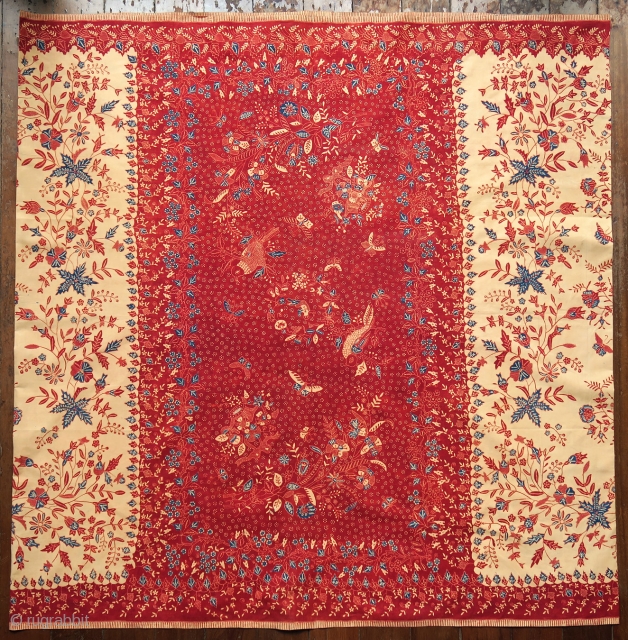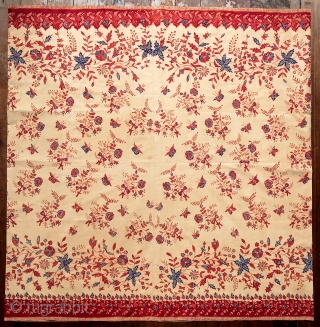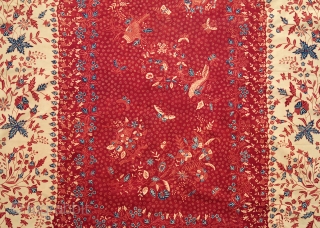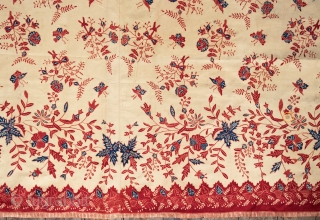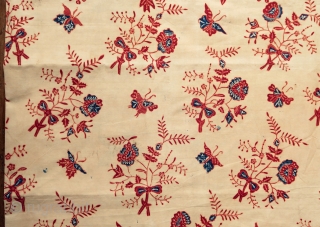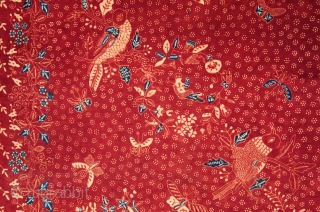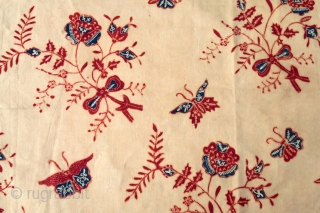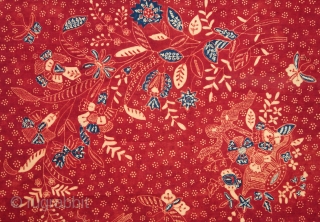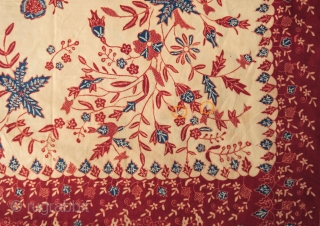Back
c. 1900 Javanese batik sarong
Origin: Indonesia, Java, Lasem, c. 1900
Technique: Commercial cotton, natural dyes, hand-drawn (tulis) batik
Description: a batik sarong hand-drawn in Lasem on the north coast of Java, of the class of pattern known by its colors as bang-biru, i.e. red-&-blue. The main body of the sarong has scattered red and blue flowering sprigs and butterflies against an ivory ground. Of special charm are the winding sprays of flowers laid loosely against the red borders, that have a different closely detailed vine at top and bottom.
The contrasting rich red head panel (kepala) has two large birds on either side of a nest with a chick inside it, suggesting that the sarong may have been made for a young mother, or for a bride in the hope that she will soon be a mother. Context: The rich red of Lasem batik was emulated in other batik centres, but never quite equalled (and a closely guarded secret). The premium set on color is shown in the Lasem classification of batiks by their color combinations, not by motifs: bang-bangan (red /cream); bang-biru (red /cream/ blue); bang-biru-ijo (red /cream /blue /green). Lasem batiks are often designed with the colors as the primary elements.
Condition: The sarong is in good condition, it has two small holes (5-6 mm), two smaller waxy stains and a few light marks (see images). The colors are both beautifully intense and vivid, and the cotton is of high quality, densely woven, thick, and with a stiff handle.
Dimensions: Length: 107 cm. Width: 102.5 cm (unopened).
Origin: Indonesia, Java, Lasem, c. 1900
Technique: Commercial cotton, natural dyes, hand-drawn (tulis) batik
Description: a batik sarong hand-drawn in Lasem on the north coast of Java, of the class of pattern known by its colors as bang-biru, i.e. red-&-blue. The main body of the sarong has scattered red and blue flowering sprigs and butterflies against an ivory ground. Of special charm are the winding sprays of flowers laid loosely against the red borders, that have a different closely detailed vine at top and bottom.
The contrasting rich red head panel (kepala) has two large birds on either side of a nest with a chick inside it, suggesting that the sarong may have been made for a young mother, or for a bride in the hope that she will soon be a mother. Context: The rich red of Lasem batik was emulated in other batik centres, but never quite equalled (and a closely guarded secret). The premium set on color is shown in the Lasem classification of batiks by their color combinations, not by motifs: bang-bangan (red /cream); bang-biru (red /cream/ blue); bang-biru-ijo (red /cream /blue /green). Lasem batiks are often designed with the colors as the primary elements.
Condition: The sarong is in good condition, it has two small holes (5-6 mm), two smaller waxy stains and a few light marks (see images). The colors are both beautifully intense and vivid, and the cotton is of high quality, densely woven, thick, and with a stiff handle.
Dimensions: Length: 107 cm. Width: 102.5 cm (unopened).
price:
SOLD
- Home
- Antique Rugs by Region
- Category
- Profiles
- Post Items Free
- Albums
- Benaki Museum of Islamic Art
- Budapest: Ottoman Carpets
- Gulbenkian Museum
- Islamic Carpets. Brooklyn
- Islamic Textiles. Brooklyn
- Konya Museum: Rugs
- MKG, Hamburg
- MMA: Caucasian Carpets
- MMA: Mamluk Carpets
- MMA: Mughal Indian Carpets
- MMA: Ottoman Carpets
- MMA: Safavid Persian Carpets
- MMA: Turkmen Rugs
- McCoy Jones Kilims
- Ottoman textiles. Met
- Philadelphia Museum
- Rugs and Carpets: Berlin
- Seljuqs at the Met
- TIEM, Istanbul: Carpets
- V&A: Classical Carpets
- Vakiflar Carpets: Istanbul
- Baluch Rugs: Indianapolis
- Gallery Exhibitions
- Jaf an Exhibition
- Alberto Levi Gallery
- Andean Textile
- Christie's London: 2016
- Francesca Galloway
- HALI at 40
- ICOC Washington, DC 2018
- Jajims of the Shahsavan
- London Islamic Week April, 2018
- Mongolian Felts
- Navajo Rugs: JB Moore
- Persian Piled Weavings
- SF Tribal & Textile Art Show 2020
- SF Tribal 2019
- Sotheby's: C. Alexander
- Turkish Prayer Rugs
- Turkmen Main Carpets ICOC 2007








